Research projects funded by other sources - Medical pluralism
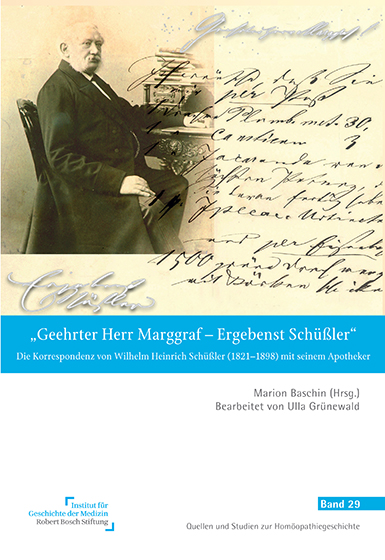
Editor: Dr. phil. Marion Baschin
The correspondence of Wilhelm Heinrich Schüßler (1821–1898) with his pharmacist
On the occasion of the 200th birthday of Wilhelm Schüßler (1821–1898), a rare treasure trove in the history of the healing method of biochemistry that he founded was published in its current volume: Around 150 letters from Schüßler to his pharmacists Albert Marggraf (1809–1880) and William Steinmetz (1855–1908) are published for the first time. These letters have been in the possession of the company Homöopathisches Laboratorium Alexander Pflüger GmbH & Co. KG in Rheda-Wiedenbrück, Germany, since 2014.
In the letters and postcards from 1867 to 1882, more than simply Schüßler's work shines through. We get to know him as an experimental and curious doctor. We now also have a better perspective on his friendship with Marggraf. When he died in November 1880, Schüßler expressed his condolences with the remark that Marggraf had "supplied him with remedies for about 20 years". The pharmacist was one of Schüßler's most ardent supporters in the otherwise rather critical homeopathic circles.
Eleven illustrations of original letters complete this extraordinary cultural and historical heritage, which provides a good complement to the study of Schüßler's biochemistry.
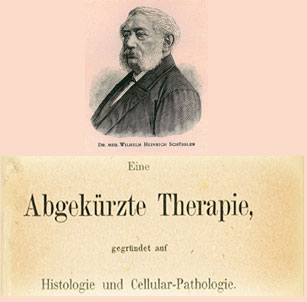
Editor: Dr. phil. Marion Baschin
The project follows on from the work completed in 2015 on self-medication with Schuessler salts. The extensive materials collected from numerous archives and libraries, including those in Oldenburg and Leipzig, are now to be evaluated and prepared for publication. The focus is on the twelve salts used by Schüßler as medicines, especially their production, sale and distribution.
During the development of his biochemical healing method, Schüßler used different potencies and made different statements regarding the intake. From 1892 onwards, he exclusively recommended the potencies D 6 and D 12, which have become the standard today. Schüßler's sources of supply – Albert Marggraf in Leipzig and the Zahn and Seeger pharmacies in Stuttgart as well as Virgil Mayer in Bad Cannstatt – and other manufacturers of the "Schuessler salts" are also considered. In 1905, around seven large pharmacies competed for successful sales of over-the-counter medicines. Numerous smaller pharmacies and factories sprang up from 1920 onwards. These and other results will be presented in the publication planned for 2019.
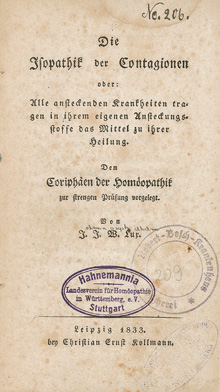
Editor: Dr. phil. Marion Baschin
What is isopathy? Finding an answer to this question is no easy task. The Leipzig veterinarian Johann Wilhelm Lux (1773–1849) was one of the first to introduce homeopathic principles in the treatment of animals. In 1833, however, he also published his work "Die Isopathik der Contagionen" (Isopathy of Contagions), in which he presented isopathy as a healing system superior to homeopathy. In it, Lux elaborated on the idea of treating diseases according to the principle of "like by like" (Aequalia Aequalibus curentur), formulating at the same time: "All contagious diseases carry in their own infectious agent the means for their cure." Lux's ideas met with the approval of Hahnemann's student Gustav Groß (1794–1847) in particular. With the consideration that isopathy was the "ideal homeopathy", however, both provoked great criticism within the homeopathic medical profession and sparked a lively discussion about whether there could be a real treatment according to the principle of equality. In the end, isopathy, or rather its remedies, were subordinated to homeopathy. Nevertheless, the debate about this therapeutic method flared up again and again. Nowadays, "isopathy" is often used as byword to mean a treatment in which pathogens are processed into remedies, and this idea is associated primarily with the biologist Günter Enderlein (1872–1968).
The idea of healing "like with like" thus continued to challenge homeopathy and "conventional medicine". Isopathy therefore also developed out of homeopathy and is in constant interaction with it. However, how should the development of isopathy and its relationship to homeopathy and "conventional medicine" be viewed in detail? What is the significance and impact of isopathy, the active substances it uses and the debates triggered by its main proponents in the field of medicine?
The answer to these questions will be provided in this third-party funded project. The main sources are the publications of Johann Wilhelm Lux and other representatives of this healing principle, corresponding articles in homeopathic journals such as the AHZ or the ZBV, and other publications on isopathy from the period of 1830 to around 1950.
The work is published in the series Quellen- und Studien zur Homöopathiegeschichte (Sources and studies on the history of homeopathy).
Isopathy and homeopathy: A correlation between rejection and integration
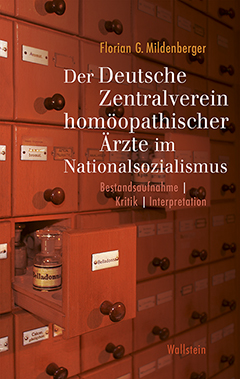
From 1933 onwards, the National Socialist rulers developed "New German medicine" as a concept of alternative medicine. The German Central Association of Homeopathic Doctors was an important player in this. Colleagues who opposed the Nazis were expelled from the ranks of the "Central Association", or at least were not supported. The vast majority of homeopathic doctors conformed to the ideological and medical guidelines of the Nazi regime. Nevertheless, in return, the "Central Association" did not achieve general recognition for homeopathy in official Nazi policy.
Florian G. Mildenberger proves in his study that the Association and its members were not, as often claimed in the past, among the medical professionals involved in the criminal human experiments committed in concentration camps. These crimes, as well as the interest of leading Nazis such as Heinrich Himmler or Rudolf Heß in naturopathic connections, were often associated with homeopathy out of ignorance on the part of contemporary witnesses and historians.
The project has now been completed and a publication is available.
Author: Prof. Dr. phil. Florian Mildenberger
Editor: Dr. phil. Marion Baschin
In 1874, Wilhelm Heinrich Schüßler published his "Abgekürzte Therapie" (Abbreviated Therapy) for the first time as his own writing. Before his death in 1898, he edited the 25th edition of the work. The discipline of biochemistry founded by Schüßler and the "Schuessler salts" named after him are still very popular today. Particularly in the case of minor complaints, the remedies are used as part of self-medication.
Today, the "Schuessler salts" are not available on prescription, but you can only buy them in pharmacies. Until the mid-20th century, however, the biochemical remedies could also be dispensed by associations, as their status as medicinal products had not yet been conclusively clarified. Similar to homeopathy, a fierce battle had arisen for Schüßler's biochemistry as to who was entitled to produce and dispense the remedies.
The project focuses primarily on the "Schuessler salts" themselves. The role of remedies in therapy and self-treatment will be explored, especially in the early days of the biochemical movement. The interest is therefore not only in the founder of the healing method, but also in biochemical pharmacies and associations. Since documents on Schüßler and his biochemistry have rarely been systematically collected in a library or archive, an important part of the project is also searching for suitable sources and meaningful documents.
The project has been completed in the meantime.
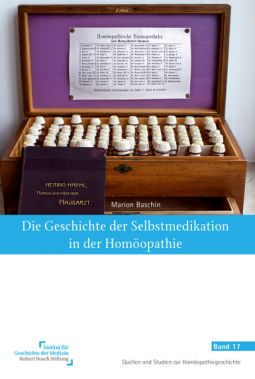
Editor: Dr. phil. Marion Baschin
How did homeopathy come to be established as such a popular self-help option? Marion Baschin addresses this question in this work, which for the first time presents the tradition of self-treatment with homeopathic remedies from the early 19th century to the mid-20th century. Among the factors that promoted self-medication with homeopathic remedies were the fundamentals of Hahnemann's teaching itself: Homeopathy was considered a simple, gentle and inexpensive method of healing. Moreover, the lack of homeopathic physicians forced people who were interested towards self-therapy, while at the same time the success of Hahnemann's teachings in treating cholera and other diseases increased its popularity. Layman's guidebooks were widespread as instructions for self-help. Home and pocket pharmacy kits offered in many places, as well as mutual information and assistance in lay associations, further encouraged self-help. The discipline of biochemistry developed by Dr. Wilhelm Schüßler and self-treatment with "Schuessler salts" are also considered in a digression. This social and medical history study thus opens up diverse aspects of self-medication with homeopathic remedies.



